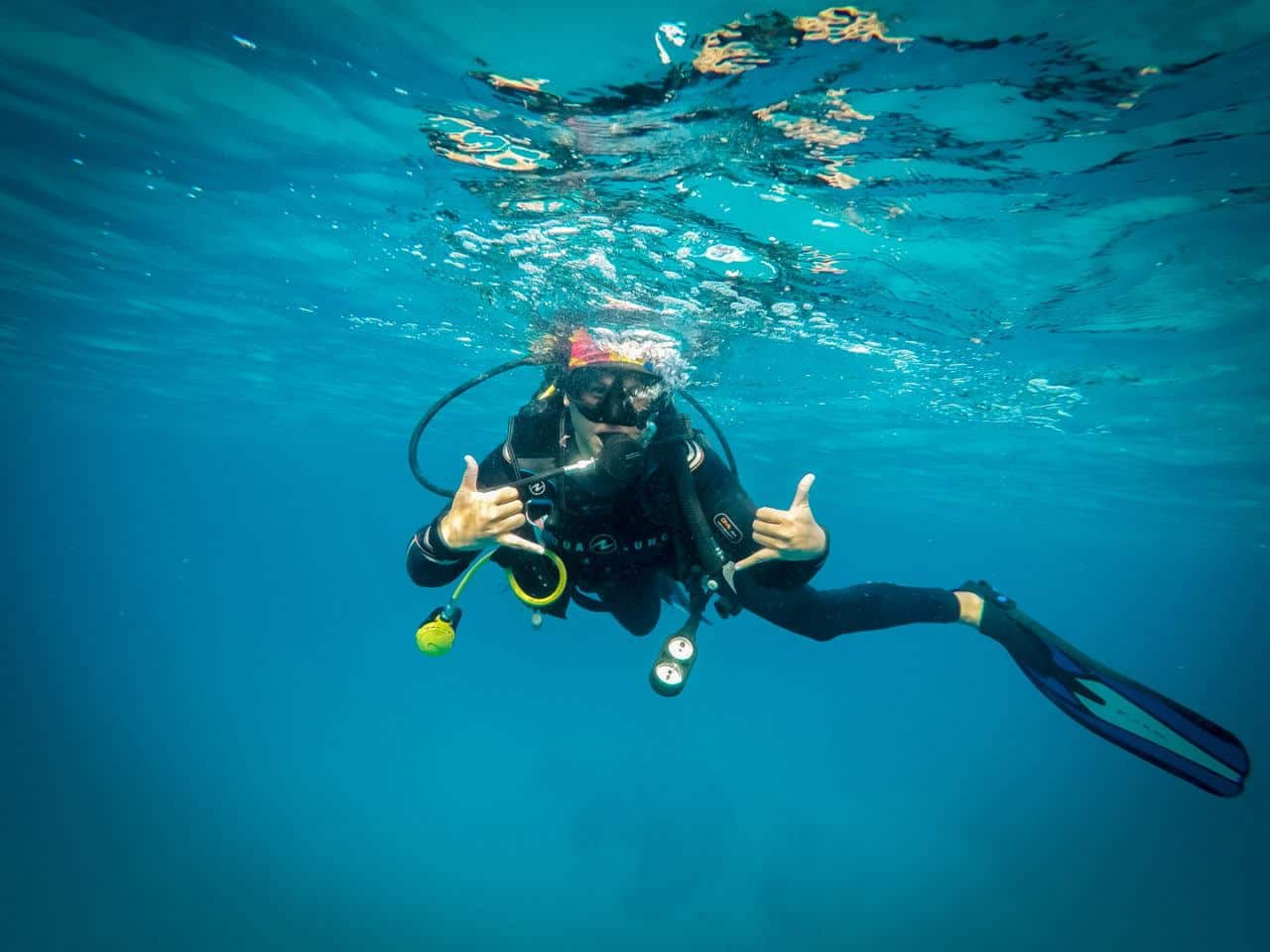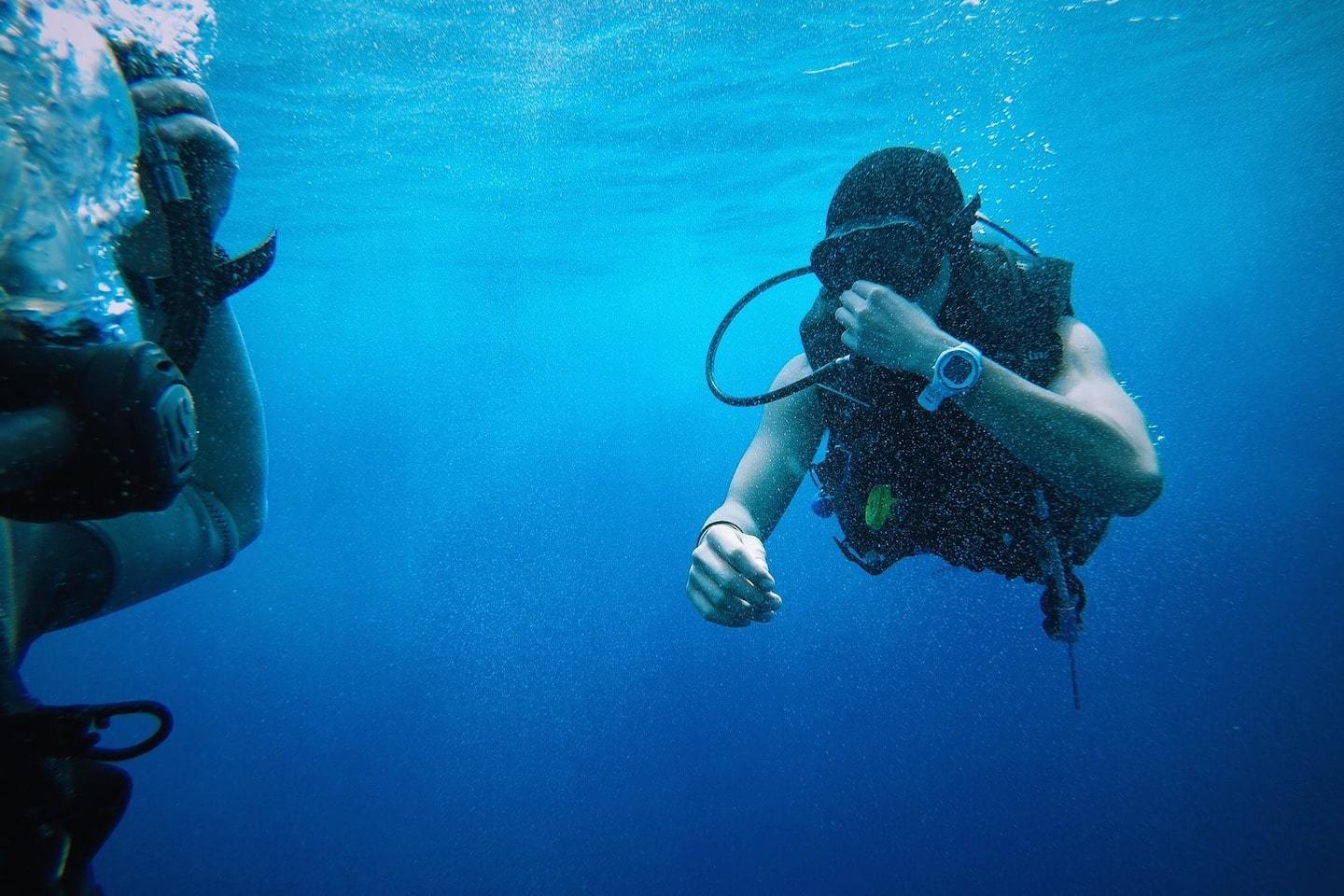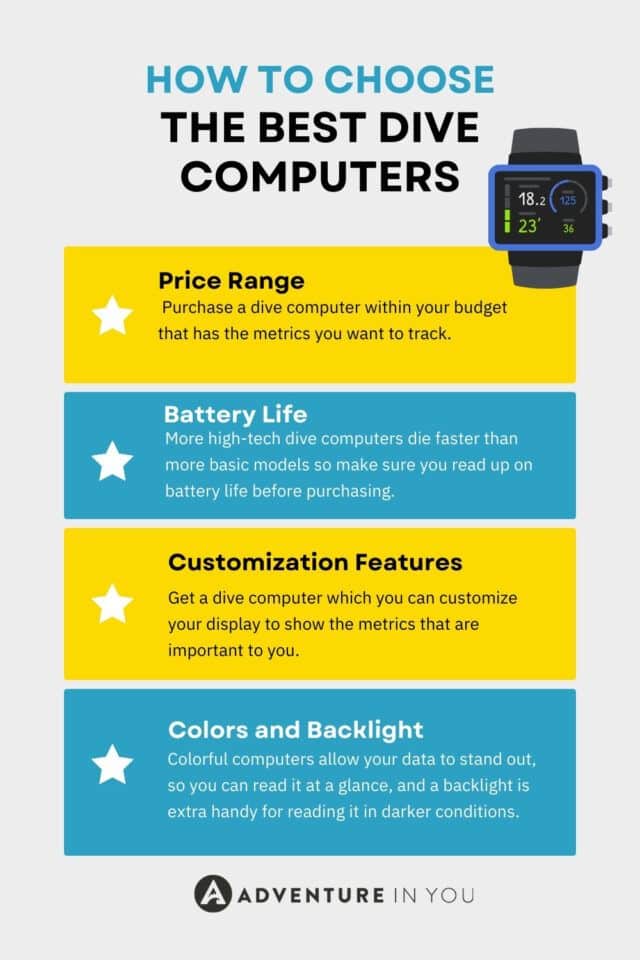The best dive computers provide the most pertinent information that people may need while underwater. Whether you’re a scuba diver, freediver, or spearfisher, a dive computer is an essential piece of gear that can do so much.
Dive computers aren’t just there to monitor your oxygen. They provide critical information about depth and are outfitted with timers and alarms to ensure you stay within your limits.
While diving is an incredible sport, there’s still a certain amount of risk that comes with exploring the depths of the ocean. A dive computer is here to mitigate some of that risk and make your diving experience that much safer.
So if you’re a novice or a pro looking for a dive computer to take on your adventures, keep reading to see the top 10 options available today, along with key considerations to keep in mind before purchasing.
View Contents
Editor’s Top Picks for the Best Dive Computers
Best Dive Computer for Beginnner

Oceanic F-10 V3
Main Features: Elapsed dive time | Repeating depth interval alarm | Rugged, durable & simple design
Skill level: Beginner
Best Advanced Dive Computer

Shearwater Teric
Main Features: Audible & vibrating alerts | Bluetooth connection to Shearwater Cloud dive log manager | Can monitor up to 2 tank pressures | Customizable screen
Skill level: Advanced
Best Budget Dive Computer

Cressi Donatello
Main Features: 3 color options | Single button navigation | Air, nitrox, gauge & free mode
Skill level: Beginner
Top Dive Computers Comparison Table
| Name | Modes | Battery Type | Bluetooth? | Price | Read Reviews |
|---|---|---|---|---|---|
| Oceanic F-10 V3 | Freedive | User-replaceable | No | $ | View on Amazon |
| Cressi Donatello | Air, Nitrox, Gauge, Free | User-replaceable | Yes | $ | View on Amazon |
| Suunto Zoop Novo | Air, Nitrox, Gauge, Free | User-replaceable | No | $ | View on Amazon |
| Mares Matrix | Air, Nitrox, Watch, Gauge | Rechargeable | No | $$ | View on Amazon |
| Aqua Lung i470TC | Air, Nitrox, Gauge, Free | User-replaceable | Yes | $$ | View on Amazon |
| Shearwater Perdix | Recreational, Technical, Closed Circuit / Bailout, Gauge | User-replaceable | Yes | $$$ | View on Amazon |
| Shearwater Teric | Open Circuit, Fixed PO2, Gauge, Free | Rechargeable | Yes | $$$$ | View on Amazon |
| Garmin Descent MK1 | Single-gas, Multi-gas, Gauge, Free | Rechargeable | Yes | $$$ | View on Amazon |
| Suunto D5 | Air, Nitrox, Gauge, Free | Rechargeable | Yes | $$$$ | View on Amazon |
| Scubapro G2 | Scuba, Free, Gauge, CCR, Sidemount | Rechargeable | Yes | $$$$ | View on Amazon |
10 Dive Computer Reviews
To help on your hunt for the best dive computer, here’s a complete round up of the 10 best options today. Whether you’re looking for a dive computer to use only in the water, or a versatile model with multiple functions, you’ll be able to find the perfect pick on this list.
Oceanic F-10 V3

Best For: Beginner use
Features: Freedive focused | Elapsed dive time | User defined surface recovery timer | Repeating depth interval alarm | Rugged, durable & simple design
Kicking things off with perhaps one of the most basic models on the market, the Oceanic F-10 V3 is the best dive computer if it’s your first one.
This computer was actually designed specifically for freediving, which is why it’s so simple. The display showcases your depth and elapsed dive time, along with different alarms to ensure you make it up with plenty of air.
Another reason the Oceanic F-10 V3 is the best freediving computer is because it has lots of different timers that can be set for surface recovery, elapsed dive time, and repeating depth. This is a total game changer for freedivers looking for valuable data, as these metrics can greatly improve your performance and keep you safe at the same time.
Designed by freedivers for freedivers, you’re likely to find this computer a practical option if you’re new to the sport but interested in improving.
Cressi Donatello

Best For: Beginner use
Features: 3 color options | Single button navigation | Air, nitrox, gauge & free mode | Audible alarms | Deep stop function | Bluetooth interface sold separately
The latest installment in Cressi’s dive computer line is the Donatello, a step up from its predecessor, the Leonardo.
It’s a basic, entry level dive computer but has all the functionality you’ll need without it becoming overwhelming. It features handy data and one-button navigation, allowing you to quickly set metrics to air, nitrox, gauge, and even freediving mode. There are also heaps of alarms that offer both visual and audio cues, and a user changeable battery.
The Cressi Donatello has an ultra bright backlit display that’s super easy to read, along with the ability to actually shut off the dive functions in case you’re simply snorkeling or swimming. While there’s no Bluetooth, you can purchase a separate interface to connect the watch to your laptop to download data.
Overall, this basic dive computer is a great first model as it’s not too expensive, with everything a novice diver will need. The one downside is that there’s no compass, but that’s made up for with the comfort and durability.
Suunto Zoop Novo

Best For: Beginner use
Features: 3 color options | Air, nitrox, gauge & freedom modes | Audible alarms | 100 meters maximum depth display | 4-button navigation | USB connection to dive manager
For a third dive computer that won’t break the bank, give the Suunto Zoop Novo a go. This easy to spot wrist console comes in three colors and has operating modes covering air, nitrox, as well as freediving if you’re diving without a tank.
It’s still a very basic model with not too much going on, but the large matrix screen and bright backlight are welcome features to ensure a smooth user experience. It operates on a four-button menu system and even has the option of a gauge mode to step things up a notch.
One large perk to this budget dive computer is that it connects via USB to Suunto’s dive manager, allowing you to properly track and record each time you venture below the ocean’s surface.
Mares Matrix

Best For: Beginner / Intermediate use
Features: High resolution display | Tilt compass | Air, nitrox, watch & gauge modes | Second time zone | 35-hour logbook | Rechargeable battery
If you’re looking for a basic dive computer that’s a little more versatile than the options above, you may really enjoy the Mares Matrix, a little device that packs a huge punch.
This dive computer operates on a full-dot matrix display that’s high resolution with a bright backlight. The four-button menu system makes it easy to find what you’re looking for, and it displays a little more than a standard dive computer, like the temperature, maximum depth and beyond.
Set it to air, nitrox, or gauge modes while in the water, and switch it to the standard watch setting when wearing it around town. It even has the option to add a second time zone!
Aside from the super sleek look and two color options, this dive computer has a rechargeable battery and hooks up to a laptop for downloading dives. There’s also a tilt compass for finding your bearings.
Mares is known for making exceptional dive equipment, and the Matrix is no exception if you’re looking for a dive computer that will last for many years.
Aqua Lung i470TC

Best For: Beginner / Intermediate use
Features: Air, nitrox, gauge & freedive modes | Bluetooth with DiverLog+ app | Wireless air integration | 3 nitrox mixes | Audible alarms
As you’re willing to spend a little more, you’ll see dive computers take a massive leap in terms of technology and functionality. The Aqua Lung i470TC is one such example, and is the best dive computer for transitioning from beginner to more advanced use.
It boasts wireless air integration, four operating modes, and three transmitters. But boy is this baby packed with features! This dive computer is committed to helping track your time underwater, with Bluetooth and a connection to Aqualung’s Diverlog+ app that allows you to not only manage your computer settings, but track your dives as well.
There are audible alarms, a bright backlight, and multiple gas settings, along with a plan mode so you’re ready when you hit the water.
While there’s no compass, there is a freedive mode, in addition to single button access to the last dive display, countdown timer, and a user-changeable standard battery.
Shearwater Perdix

Best For: Technical use
Features: Integrated bungee mount | High resolution, vivid color display | 1000-hour dive log | Bluetooth compatibility | 850 feet maximum depth
Don’t mind spending more for added features? This is among the best dive computers as we get into the advanced realm.
Shaped less like a standard watch and more like a mini computer, the Shearwater Perdix has bungee and classic strap mounts to give you a range of ways to wear it comfortably.
With a vivid, backlit color display on the large screen, you’ll always have an accurate handle of what’s going on and be able to toggle between settings quickly and with ease. It comes with a 1,000-hour dive log that can be transferred to either your Mac or PC using Bluetooth to better analyze your time underwater.
It runs on a AA battery, which means that it can be changed extremely easily, and the intuitive user interface will make it a breeze to set it and go.
This dive computer has a whopping 850 feet of operating depth, in addition to three gas settings, and a completely customizable screen so that you can decide what you want to see and get rid of the rest.
Shearwater Teric

Best For: Advanced use
Features: Audible & vibrating alerts | Modes: recreational, gauge, freediving, open-circuit tech & closed-circuit | Bluetooth connection to Shearwater Cloud dive log manager | Can monitor up to 2 tank pressures | Customizable screen
Another knockout model from Shearwater is the Teric, which is even more advanced than the previous option.
It’s designed for nitro trimix decompression, which is why it’s best for technical divers, but still works as a standard dive computer, too. It can be used for open or closed-circuit air, and has tons of modes, including recreational, gauge, and freediving, to name a few.
One of the coolest elements of this dive computer is it has vibrating alarms if you prefer this to audio (though this is still an option), along with a color-rich, backlit display.
Finishing out with Bluetooth connectivity, a rechargeable battery, and features that both advanced and novice divers will benefit from, there’s no question this is one of the best dive computers on the market today.
Garmin Descent MK1

Best For: Advanced use
Features: 3 color options | 3-axis compass | GPS capability | Single-gas, multi-gas, gauge & free dive modes | 200-dive log book | Elevate wrist heart rate technology | Multi-sport activity profiles | Smart notifications
This versatile dive computer is a well loved model within this scuba community. It’s perfect for tracking your progress, but also versatile enough to use it out of the water, too.
Outfitted with full GPS features, a rarity in this size dive computer, the Garmin Descent MK1 allows you to log your entry and exit points for easy surface navigation, which is one of the most unique features out there. Thanks to the full color display, you’ll even be able to see onscreen mapping for location reference… Talk about high tech!
This dive computer has multiple navigation sensors, including a 3-axis compass, and allows you to plan dives so you know exactly what you’re getting up to, whether you’re freediving or using a tank.
In terms of other stand out features, this Garmin watch has a wrist-based heart monitor, advanced multisport features, and smart connectivity via Bluetooth. Simply connect your dive computer to your phone and use it as a Smart Watch!
While it’s easy to get swept away by all the fun functions here, this dive computer is perfectly practical with a 40 hour battery life in between charges (when set to dive mode), dive log with 200 dives, and support for a huge range of dive types.
Suunto D5

Best For: Intermediate / Advanced use
Features: 4 color options | Customizable strap | Air, nitrox, gauge, freedive, watch modes | High quality color display | Bluetooth connection to Suunto app | Water resistant to 100 meters
In terms of sheer style, the Suunto D5 takes the cake. With a vibrant color display and exceptionally easy to read interface, this is the best dive computer if you want something that can double as an everyday watch.
This is one of the easiest to use dive computers out there, with modes covering air, nitrox, gauge, freediving and standard watch. Rather than cluttering the screen with technical data, the Suunto D5 is a breeze to flick through to see your metrics while keeping the important numbers front and center.
It connects seamlessly with Suunto’s app to allow you to relive your dives, and even has interchangeable straps so you can customize it to your individual style.
There’s lots to love about this dive computer, for both intermediate and advanced divers. Though it’s on the upper end of the price spectrum, we honestly believe it’s worth every penny.
Scubapro G2

Best For: Technical use
Features: Vibrant color thin-film transistor display | Long battery life | Intuitive menu | Hoseless air integration | Heart rate monitor sold separately
A final option for the best dive computers is the Scubapro G2, a dependable model with a full-color, dot matrix screen.
It’s super easy to read the data on this computer as everything’s split into four quadrants. Your eyes won’t have to wander looking for information, as the backlight permits it to be right in front of you at all times, and the display is 100% customizable to show what works best for you.
This dive computer is packed with features in it’s 3-button control, but can be as simple as you like for less technical dives. The menu is intuitive and allows you to switch between air and freediving modes, and it comes with a hoseless air integration to help monitor tank pressure. It even allows you to program up to 8 nitrox or trimix mixes to match any kind of diving scenario!
Whether you’re freediving, scuba, gauge or beyond, this technical yet versatile computer was designed to help you thrive underwater.
Psst...Want in on a Secret? 🤫

We've scoured the internet for the best ALL-AROUND travel shoe and Tropicfeel wins by far. We've taken ours through rivers, jungles, and cities and they're still alive and kickin'. Check them out below.
What is a Dive Computer & Why You Need One
If you’re looking for a dive computer, chances are you already know what they are, but in case you need a little refresher, a dive computer is a little device that provides real time data regarding your dive. It’s not an actual full size computer, but more of a watch that can withstand pressure and water.
Dive computers can show you tons of metrics about your dive like no stop limits, depth, ascent rate, and rest time, as well as how long you can stay underwater and when you should resurface. They also showcase previous dive information so that you can track your activity and adjust as needed.
But dive computers go beyond the basics and also provide life saving information like emergency decompression, your heart rate and nitrogen exposure, along with a tilt compass, air-integration and more. They have tons of different alarms you can set to alert you to crucial information, and plenty of bonus features as well.
When it comes down to it, all advanced divers, or anyone who would like to improve in the sport, need a dive computer. Aside from providing invaluable information while your dive is actually in progress and keeping you safe at deeper depths, these little devices allow you to log your dives, analyze your performance and make any adjustments to improve your time underwater.
They’re certainly an investment, but one that’s well worth it in the end.

How to Choose the Best Dive Computers
There are a few elements or features you’ll want to keep in mind when you’re on the hunt for the best dive computer. These key considerations will allow you to choose the absolute best dive computer for your purposes!
Experience
More than anything, you’ll want to think about your experience level when you look to purchase a dive computer.
Are you a total beginner who wants a dive computer? You’ll probably be just fine with the most basic model, without tons of bells and whistles. There’s really no need to go out and spend more than $500 on a dive computer if you aren’t even sure if you’ll stick with the sport. Plus, having tons of extra features may detract from the data you really need and should be focusing on as a novice freediver.
But if you’re a more intermediate or advanced diver, it may be well worth the investment to get a high-tech model that displays all the pertinent information you’ll need now and in the future. You may really benefit from having a dive watch that you can “grow into” if you have a long term commitment to diving. And with lots of extra features, your dive computer can easily double as an everyday watch.
Price Range
Piggybacking off of experience level, you’ll also want to think about price. Even if you’re an advanced diver, don’t feel like you have to spend thousands of dollars on a dive computer.
It’s best to purchase something within your budget that has basic functionality. Everything beyond metrics like no stop limits, depth and ascent time aren’t altogether necessary, especially if you’re just looking for a device to track your dives.
That being said, if you’d rather have a dive computer that’s useful out of the water, and can transform into a Smart Watch through a Bluetooth connection, it may be well worth it to spend those extra few bucks to get a computer with multiple uses.
Battery Life
Before purchasing a dive computer, definitely be sure to read up on the battery life. While some dive computers are rechargeable with a decent battery life, others require you to change the battery entirely when they die.
Battery lives can last anywhere from a few hours to a few days, and you may find that the more high-tech dive computers die faster than more basic models. It’s up to you whether you’ll want to charge your dive computer every night while diving, or opt for one that lasts forever.
Keep this in mind while looking at different dive computers, and if battery life is important to you, be sure that your purchase reflects this! It’s no use having a dive computer if it’s dead every time you reach for it.

Bluetooth Option
You’ll find that beyond basic dive functions, lots of the more high end dive computers have the option to connect to Bluetooth. This allows you to not only upload your data and save it long term, but it enables you to use many dive computers as a Smart Watch.
So if you’re an avid diver who’s always wanted a Smart Watch, you may want to invest in a model with Bluetooth capabilities for this added functionality.
Customization Features
Look out for any customizable features your dive computer may have. This includes changing the dive functions to display what’s most important to you, and adding features that make it easy to read and most useful for your dives.
Customization may include different alarms and vibrating alerts, various watch faces, and a display that showcases the metrics you choose.
If you’re an avid freediver, you’ll also want to make sure that you choose a computer with a freediving mode to accurately collect your data.
Some dive computers even come with interchangeable straps to customize them to your personal style… How cool is that?
Colors and Backlight
Picking a dive computer that has different colors and a backlight can greatly improve its usability. Colorful computers allow your data to stand out, so you can read it at a glance, and a backlight is extra handy for reading it in darker conditions.
No matter what, you’ll want to choose a dive computer that has an easy to read display so that you know what’s going on at all times. Otherwise, it kind of defeats the purpose of wearing one.
Ease of Use
Finally, think about how easy it is to use your dive computer. The absolute last thing you want is to spend precious time underwater fiddling with the settings to find what you’re looking for.
Instead, choose a dive computer that will be easy for you to use, even in stressful situations. Be sure to pick something with a clear display that has a simple interface so that you won’t have to struggle to use it.
If you do choose to go with a more complicated dive computer, be sure to play with it plenty prior to getting in the water to truly understand how it works beforehand.

Dive Computer FAQs
If you still have some questions about the best dive computers, here are some FAQs for more information.
Who makes the best dive computers?
There’s no single brand that makes the best dive computers, because it all depends on what you’re looking for. Cressi and Mares, reputable diving gear brands, make outstanding beginner dive computer models, while Suunto and Garmin ramp things up a notch with their more advanced configurations.
What is the best budget dive computer?
The best budget dive computer is either the Oceanic F-10 V3 which was built to last, or the Suunto Zoop Novo which is well beloved by novice divers for it’s simple functionality.
What dive computer can be used as an everyday watch?
There are actually tons of dive computers that can be used as everyday watch, as many of them were designed with a designated “watch mode.” Some examples of this are the Garmin Descent MK1 and the Suunto D5.
And there you have it, our complete round up of the best dive computers. Hopefully, you’ve found not only your next diving companion but a versatile piece of equipment that will last you for years to come.
Looking for more diving content? Check out these articles:
- 10 Best Freediving Fins: Top Picks for All Levels (2024)
- Best Freediving Mask: Top 10 Low Volume Masks in 2024
- A Complete Guide to Freediving Gear for All Levels [2024 Edition]
Inspired? Pin it!
